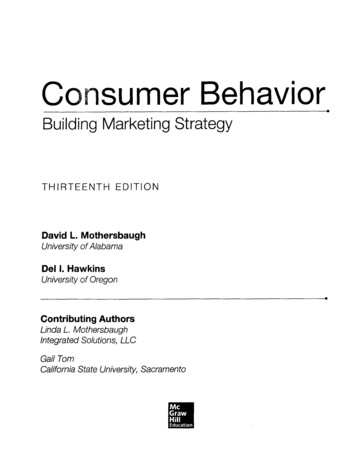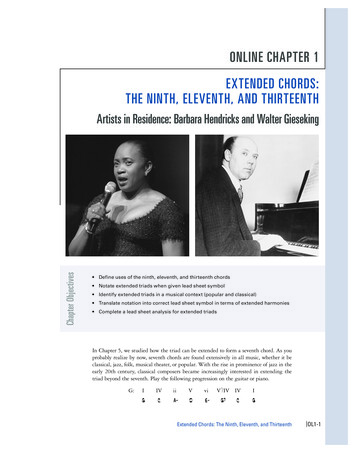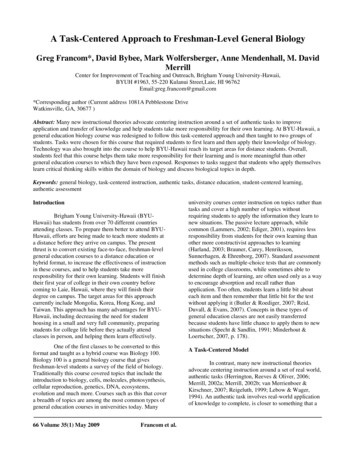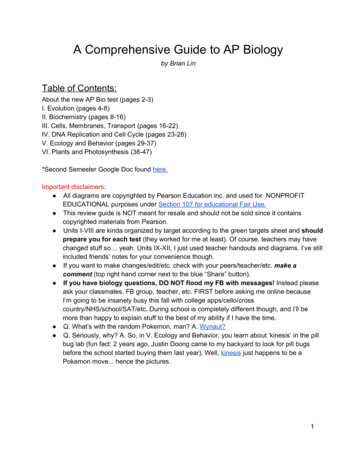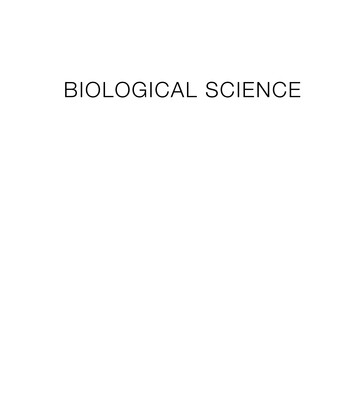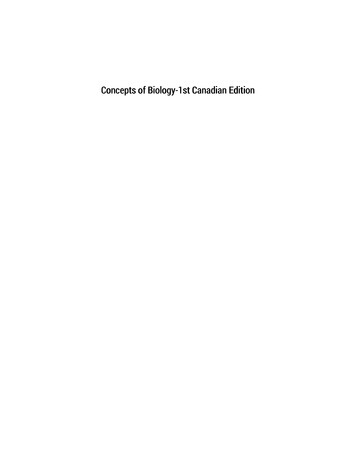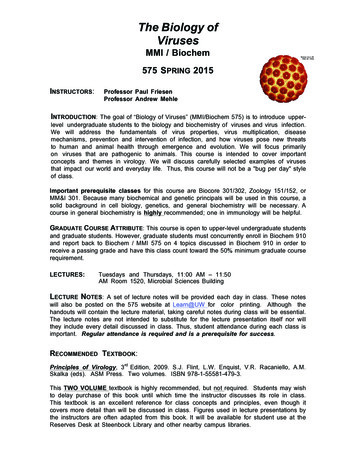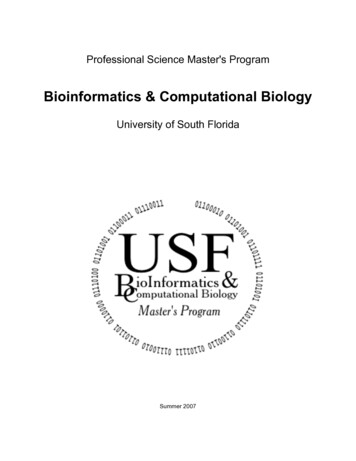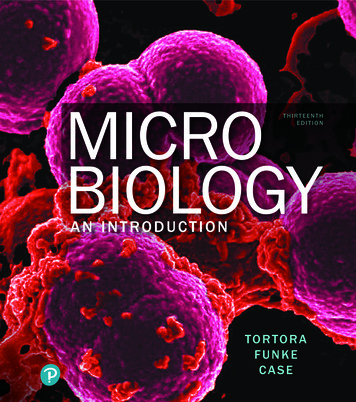
Transcription
MICROBIOLOGYTHIRTEENTHEDITIONAN INTRODUCTIONTO R TO R AFUNKECASE
A00 TORT5180 13 SE NASTA FEP.indd Page 3 11/10/17 7:56 PM user/203/PH03334/9780134605180 TORTORA/TORTORA MICROBIOLOGY13 SE 9780134605180/SE/MAI .Cutting Edge Microbiology Researchfor Today’s LearnersThe 13th Edition of Tortora, Funke, and Case’s Microbiology: An Introduction brings a 21st-century lensto this trusted market-leading introductory textbook. New and updated features, such as Exploring theMicrobiome boxes and Big Picture spreads, emphasize how our understanding of microbiology isconstantly expanding. New In the Clinic Video Tutors in MasteringTM Microbiology illustrate howstudents can apply their learning to their future careers. Mastering Microbiology also includes newReady-to-Go Teaching Modules that guide you through the most effective teaching tools available.
A00 TORT5180 13 SE NASTA FEP.indd Page 4 11/10/17 7:56 PM user/203/PH03334/9780134605180 TORTORA/TORTORA MICROBIOLOGY13 SE 9780134605180/SE/MAI .Do your students struggle to makeconnections between courseNEW! Exploring the Microbiome boxes illustrate howresearch in microbiology is revolutionizing our understandingof health and disease. These boxes highlight the possibilitiesin this exciting field and present insights into some of thenewly identified ways that microbes influence human health.In addition, they provide examples of how research in thisfield is done—building on existing information, designingfair testing, drawing conclusions, and raising new questions.
A01 TORT5180 13 SE NASTA FM.indd Page 1 11/10/17 9:30 PM user/203/PH03334/9780134605180 TORTORA/TORTORA MICROBIOLOGY13 SE 9780134605180/SE/MAI .content and their future careers?New! In the Clinic Video Tutors bring to lifethe scenarios in the chapter-opening In the Clinicfeatures. Concepts related to infection control,principles of disease, and antimicrobial therapies areintegrated throughout the chapters, providing aplatform for instructors to introduce clinicallyrelevant topics throughout the term. Each VideoTutor has a series of assessments assignable inMastering Microbiology that are tied to learningoutcomes.NEW! Ready-to-Go Teaching Modules inthe Instructor Resources of Mastering Microbiologyhelp instructors efficiently make use of the availableteaching tools for the toughest topics in microbiology.Pre-class assignments, in-class activities, and post-classassessments are provided for ease of use.Within the Ready-to-Go Teaching Modules, Adopt aMicrobe modules enable instructors to select specificpathogens for additional focus throughout the text.
A01 TORT5180 13 SE NASTA FM.indd Page 2 11/10/17 9:30 PM user/203/PH03334/9780134605180 TORTORA/TORTORA MICROBIOLOGY13 SE 9780134605180/SE/MAI .Do your students need helpunderstanding the toughestInteractive Microbiology is a dynamic suite ofinteractive tutorials and animations that teach keymicrobiology concepts. Students actively engage witheach topic and learn from manipulating variables,predicting outcomes, and answering assessmentquestions that test their understanding of basic conceptsand their ability to integrate and build on these concepts.These are available in Mastering Microbiology.NEW! Even more InteractiveMicrobiology modules are availablefor Fall 2018. Additional titles include: Antimicrobial Resistance: MechanismsAntimicrobial Resistance: SelectionAerobic Respiration in ProkaryotesThe Human Microbiome
A01 TORT5180 13 SE NASTA FM.indd Page 3 11/10/17 9:30 PM user/203/PH03334/9780134605180 TORTORA/TORTORA MICROBIOLOGY13 SE 9780134605180/SE/MAI .concepts in microbiology?MicroBoosters are a suite of brief video tutorialsthat cover key concepts some students may needto review or relearn. Titles include Study Skills, Math,Scientific Terminology, Basic Chemistry, Cell Biology, andBasic Biology.Dynamic Study Modules help students acquire,retain, and recall information faster and more efficientlythan ever before. The flashcard-style modules areavailable as a self-study tool or can be assigned by theinstructor.NEW! Instructors can nowremove questions fromDynamic Study Modules tobetter fit their course.
A01 TORT5180 13 SE NASTA FM.indd Page 4 11/10/17 9:30 PM user/203/PH03334/9780134605180 TORTORA/TORTORA MICROBIOLOGY13 SE 9780134605180/SE/MAI .Do your students have troubleorganizing and synthesizingBig Picture spreads integrate textand illustrations to help students gain abroad, “big picture” understanding ofimportant course topics.B IG P IC TU R EBioterrorismBiological agents were first tapped by armies, and now by terrorists. Today,technology and ease of travel increase the potential damage.Each Big Picture spread includesHistory of Bioweaponsan overview that breaks down importantconcepts into manageable steps and givesstudents a clear learning framework forrelated chapters. Each spread includes KeyConcepts that help students make theconnection between the presented topicand previously learned microbiologyprinciples. Each spread is paired with acoaching activity and assessmentquestions in Mastering Microbiology.Biological weapons (bioweapons)—pathogens intentionally used forhostile purposes—are not new. The “ideal” bioweapon is one thatdisseminates by aerosol, spreads efficiently from human to human,causes debilitating disease, and has no readily available treatment.The earliest recorded use of a bioweapon occurred in 1346during the Siege of Kaffa, in what is now known as Feodosia,Ukraine. There the Tartar army catapulted their own dead soldiers’plague-ridden bodies over city walls to infect opposing troops.Survivors from that attack went on to introduce the “Black Death”to the rest of Europe, sparking the plague pandemic of 1348–1350.In the eighteenth century, blankets contaminated with smallpoxwere intentionally introduced into Native American populations bythe British during the French and Indian War. And during the SinoJapanese War (1937–1945), Japanese planes dropped canisters offleas carrying Yersinia pestis bacteria, the causative agent ofplague, on China. In 1975, Bacillus anthracis endospores wereaccidentally released from a bioweapon production facility inSverdlovsk.Biological Weapons Banned in theTwentieth CenturyThe Geneva Conventions are internationally agreed upon standardsfor conducting war. Written in the 1920s, they prohibited deployingbioweapons—but did not specify that possessing or creating themwas illegal. As such, most powerful nations in the twentieth centurycontinued to create bioweapons, and the growing stockpiles posed anever-growing threat. In 1975, the Biological Weapons Conventionbanned both possession and development of biological weapons. Themajority of the world’s nations ratified the treaty, which stipulated thatany existing bioweapons be destroyed and related research halted.SEMSEM1 mmTEM0.4 mm2 mm(Clockwise from top left): Bacillus anthracis, Ebolavirus, and Vibrio choleraeare just a few microbes identified as potential bioterrorism agents.Emergence of BioterrorismA citadel in Ukraine, location of the first known biowarfare attackin history.Selected Diseases Identified as Potential Bioweapons696BacterialViralAnthrax (Bacillus anthracis)Nonbacterial meningitis(Arenaviruses)Psittacosis (Chlamydophilapsittaci)Hantavirus diseaseBotulism (Clostridium botulinumtoxin)Hemorrhagic fevers (Ebola,Marburg, Lassa)Tularemia (Francisella tularensis)MonkeypoxCholera (Vibrio cholerae)Nipah virus infectionPlague (Yersinia pestis)SmallpoxUnfortunately, the history of biowarfare doesn’t end with theratification of the Biological Weapons Convention. Since then, themain actors engaging in biowarfare have not been nations butrather radical groups and individuals. One of the most publicizedbioterrorism incidents occurred in 2001, when five people diedfrom, and many more were infected with, anthrax that an armyresearcher sent through the mail in letters.Map showing location of 2001 bioterrorism anthrax attacks.
A01 TORT5180 13 SE NASTA FM.indd Page 5 11/10/17 9:30 PM user/203/PH03334/9780134605180 TORTORA/TORTORA MICROBIOLOGY13 SE 9780134605180/SE/MAI .visual information?Three Big Picture spreads focus onimportant fundamental topics inmicrobiology:Play MicroFlix 3D Animation@MasteringMicrobiology MetabolismPublic Health Authorities Try to Meet the Threat of BioterrorismOne of the problems with bioweapons is that they contain livingorganisms, so their impact is difficult to control or even predict.However, public health authorities have created some protocols todeal with potential bioterrorism incidents. Genetics ImmunityVaccination: A Key DefenseWhen the use of biological agents is considered a possibility,military personnel and first -responders (health care personnel andothers) are vaccinated—if a vaccine for the suspected agentexists. New vaccines are being developed, and existing vaccinesare being stockpiled for use where needed.The current plan to protect civilians in the event of an attackwith a microbe is illustrated by the smallpox preparedness plan.This killer disease has been eradicated from the population, butunfortunately, a cache of the virus remains preserved in researchfacilities, meaning that it might one day be weaponized. It’s notpractical to vaccinate all people against the disease. Instead, theU.S. government’s strategy following a confirmed smallpoxoutbreak includes “ring containment and voluntary vaccination.”A “ring” of vaccinated/protected individuals is built around thebioterrorism infection case and their contacts to prevent furthertransmission.Eight Big Picture spreads focus on diseasesand related public health issues thatpresent complex real-world challenges: Vaccine-Preventable Diseases The Hygiene Hypothesis Neglected Tropical Diseases Vertical Transmission: Mother to ChildBiological hazard symbol. Climate Change and DiseaseNew Technologies and Techniques toIdentify Bioweapons BioterrorismMonitoring public health, and reporting incidence ofdiseases of note, is the first step in any bioterrorismdefense plan. The faster a potential incident isuncovered, the greater the chance for containment.Rapid tests are being investigated to detect geneticchanges in hosts due to bioweapons even beforesymptoms develop. Early-warning systems, such asDNA chips or recombinant cells that fluoresce in thepresence of a bioweapon, are also being developed. Cholera After Natural Disasters STI Home Test KitsExamining mail for B. anthracis.KEY CONCEPTS Pro Strips Rapid Screening System, developed by ADVNT BiotechnologiesLLC, is the first advanced multi-agent biowarfare detection kit thattests for anthrax, ricin toxin, botulinum toxin, plague, and SEB(staphylococcal enterotoxin B). Vaccination is critical to preventing spread of infectious diseases,especially those that can be weaponized. (See Chapter 18,“Principles and Effects of Vaccinations,” pages 500–501.)Many organisms that could be used for weapons require BSL-3facilities. (See Chapter 6, “Special Culture Techniques,”pages 161–162.)Tracking pathogen genomics provides information on its source.(See Chapter 9, “Forensic Microbiology,” pages 258–260.)697
A01 TORT5180 13 SE NASTA FM.indd Page 6 11/11/17 9:34 AM user/203/PH03334/9780134605180 TORTORA/TORTORA MICROBIOLOGY13 SE 9780134605180/SE/MAI .Additional Instructor andStudent ResourcesLearning Catalytics is a “bring your own device”(laptop, smartphone, or tablet) student engagement,assessment, and classroom intelligence system. WithLearning Catalytics, instructors can assess students inreal time using open-ended tasks to probe studentunderstanding. Mastering Microbiology users mayselect from Pearson’s library of questions designedespecially for use with Learning Catalytics.Instructor Resource Materials forMicrobiology: An IntroductionThe Instructor Resource Materials organize allinstructor media resources by chapter into oneconvenient and easy-to-use package containing: All figures, photos, and tables from the textbookin both labeled and unlabeled formats TestGen Test BankMastering MicrobiologyUpon textbook purchase, students and teachers aregranted access to Mastering Microbiology withPearson eText. High school teachers can obtainpreview or adoption access to Mastering Microbiologyin one of the following ways:Preview Access MicroFlix animations Teachers can request preview access online by Instructor’s Guidevisiting www.PearsonSchool.com/Access Request.Select Science, choose Initial Access, and completethe form under Option 2. Preview Accessinformation will be sent to the teacher via e-mail.A wealth of additional classroom resources can bedownloaded from the Instructor Resources area ofMastering Microbiology.Laboratory Experiments in Microbiology,12th Edition by Johnson/CaseAdoption Access With the purchase of this program, a PearsonAdoption Access Card with Instructor Manualwill be delivered with your textbook purchase.(ISBN: 978-0-13-354087-1)0-134-60520-9 / 978-0-134-60520-3Available for purchase.LABOR ATORY MANUALLaboratory Experiments inMICROBIOLOGY12TH EDITIONJOHNSONCASEEngaging,comprehensive andcustomizable,Laboratory Experimentsin Microbiologyis the perfect companionlab manual forMicrobiology:An Introduction,13th Edition. Ask your sales representative for a PearsonAdoption Access Card with Instructor Manual.(ISBN: 978-0-13-354087-1)OR Visit PearsonSchool.com/Access Request, selectScience, choose Initial Access, and complete theform under Option 3—MyLab/Mastering ClassAdoption Access. Teacher and Student accessinformation will be sent to the teacher via e-mail.Students, ask your teacher for accessPearson reserves the right to change and/or update technology platforms, including possible edition updates to customers during theterm of access. This will allow Pearson to continue to deliver the most up-to-date content and technology to customers. Customer willbe notified of any change prior to the beginning of the new school year.
A01 TORT5180 13 SE NASTA FM.indd Page 1 11/10/17 9:31 PM user/203/PH03334/9780134605180 TORTORA/TORTORA MICROBIOLOGY13 SE 9780134605180/SE/MAI .MICROBIOLOGYAN INTRODUCTIONTHIRTEENTH EDITIONGerard J. TortoraBERGEN COMMUNITY COLLEGEBerdell R. FunkeNORTH DAKOTA STATE UNIVERSITYChristine L. CaseSKYLINE COLLEGE
A01 TORT5180 13 SE NASTA FM.indd Page 2 11/10/17 9:31 PM userEditor-in-Chief: Serina BeauparlantCourseware Portfolio Manager: Jennifer McGill WalkerManaging Producer: Nancy TaborContent & Design Manager: Michele Mangelli, Mangelli Productions, LLCCourseware Director, Content Development: Barbara YienCourseware Sr. Analyst: Erin StrathmannCourseware Editorial Assistant: Dapinder DosanjhRich Media Content Producer: Lucinda Bingham and Tod ReganProduction Supervisor: Karen GulliverCopyeditor: Sally PeyrefitteProofreaders: Betsy Dietrich and Martha Ghent/203/PH03334/9780134605180 TORTORA/TORTORA MICROBIOLOGY13 SE 9780134605180/SE/MAI .Compositor: iEnergizer Aptara , LtdArt Coordinator: Jean LakeInterior & Cover Designer: Hespenheide DesignIllustrators: Imagineering STA Media Services, Inc.Rights & Permissions Management: Ben FerriniRights & Permissions Project Manager: Cenveo Publishing Services,Matt PerryPhoto Researcher: Kristin PiljayManufacturing Buyer: Stacey WeinbergerDirector of Product Marketing, Science: Allison RonaCover photo: Science SourceCopyright 2019, 2016, 2013 Pearson Education, Inc. All Rights Reserved. Printed in the United States of America.This publication is protected by copyright, and permission should be obtained from the publisher prior to any prohibited reproduction, storage in a retrieval system, or transmission in any form or by any means, electronic, mechanical, photocopying, recording, or otherwise. For information regarding permissions, request forms and the appropriatecontacts within the Pearson Education Global Rights & Permissions department, please visit www.pearsoned.com/permissions/.Acknowledgments of third-party content appear on page C-1, which constitutes an extension of this copyright page.PEARSON, ALWAYS LEARNING, MasteringTM Microbiology, MicroFlix, Interactive Microbiology, and Microboosters,are exclusive trademarks in the U.S. and/or other countries owned by Pearson Education, Inc. or its affiliates.Unless otherwise indicated herein, any third-party trademarks that may appear in this work are the property of theirrespective owners and any references to third-party trademarks, logos, or other trade dress are for demonstrative ordescriptive purposes only. Such references are not intended to imply any sponsorship, endorsement, authorization,or promotion of Pearson’s products by the owners of such marks, or any relationship between the owner and PearsonEducation, Inc. or its affiliates, authors, licensees, or distributors.Trademark attributions are listed on page T-1.Library of Congress Cataloging-in-Publication DataNames: Tortora, Gerard J., author. Funke, Berdell R., author. Case,Christine L., 1948- , author.Title: Microbiology : an introduction / Gerard J. Tortora, Bergen CommunityCollege, Berdell R. Funke, North Dakota State University, Christine L.Case, Skyline College.Description: Thirteenth edition. Boston : Pearson, [2019] Includesbibliographical references and index.Identifiers: LCCN 2017044147 ISBN 9780134605180 (student edition) ISBN 0134605187 (student edition) ISBN 9780134709260 (instructor’s review copy) ISBN 0134709268 (instructor’s review copy)Subjects: LCSH: Microbiology.Classification: LCC QR41.2 .T67 2019 DDC 579--dc23 LC record available athttps://lccn.loc.gov/2017044147117ISBN 10: 0-13-477430-2 (High School Binding)ISBN 13: 978-0-13-477430-5 (High School Binding)www.PearsonSchool.com/Advanced
A01 TORT5180 13 SE NASTA FM.indd Page 3 11/10/17 9:31 PM user/203/PH03334/9780134605180 TORTORA/TORTORA MICROBIOLOGY13 SE 9780134605180/SE/MAI .About the AuthorsGerard J. Tortora Jerry Tortora is professor of biology and formerbiology coordinator at Bergen Community College in Paramus, NewJersey. He received his bachelor’s degree in biology from FairleighDickinson University and his master’s degree in science education fromMontclair State College. He has been a member of many professionalorganizations, including the American Society of Microbiology (ASM),the Human Anatomy and Physiology Society (HAPS), the AmericanAssociation for the Advancement of Science (AAAS), the National Education Association(NEA), and the Metropolitan Association of College and University Biologists (MACUB).Above all, Jerry is devoted to his students and their aspirations. In recognition of thiscommitment, MACUB presented Jerry with the organization’s 1992 President’s MemorialAward. In 1995, he was selected as one of the finest faculty scholars of Bergen CommunityCollege and was named Distinguished Faculty Scholar. In 1996, he received a NationalInstitute for Staff and Organizational Development (NISOD) excellence award from theUniversity of Texas and was selected to represent Bergen Community College in a campaignto increase awareness of the contributions of community colleges to higher education.Jerry is the author of several best-selling science textbooks and laboratory manuals, acalling that often requires an additional 40 hours per week beyond his full-time teachingresponsibilities. Nevertheless, he still makes time for four or five weekly aerobic workouts. Healso enjoys attending opera performances at the Metropolitan Opera House, Broadway plays,and concerts. He spends his quiet time at his beach home on the New Jersey Shore.To all my children, the most important gift I have: Lynne, Gerard Jr., Kenneth, Anthony,and Drew, whose love and support have been such an important part of my personal life andprofessional career.Berdell R. FunkeBert Funke received his Ph.D., M.S., and B.S. inmicrobiology from Kansas State University. He has spent his professionalyears as a professor of microbiology at North Dakota State University.He taught introductory microbiology, including laboratory sections,general microbiology, food microbiology, soil microbiology, clinicalparasitology, and pathogenic microbiology. As a research scientist in theExperiment Station at North Dakota State, he has published numerouspapers in soil microbiology and food microbiology.Christine L. Case Chris Case is a professor of microbiology atSkyline College in San Bruno, California, where she has taught for thepast 46 years. She received her Ed.D. in curriculum and instruction fromNova Southeastern University and her M.A. in microbiology from SanFrancisco State University. She was Director for the Society for IndustrialMicrobiology and is an active member of the ASM. She received the ASMand California Hayward outstanding educator awards. Chris receivedthe SACNAS Distinguished Community College Mentor Award for her commitment to herstudents, several of whom have presented at undergraduate research conferences and wonawards. In addition to teaching, Chris contributes regularly to the professional literature,develops innovative educational methodologies, and maintains a personal and professionalcommitment to conservation and the importance of science in society. Chris is also an avidphotographer, and many of her photographs appear in this book.I owe my deepest gratitude to Don Biederman and our three children, Daniel, Jonathan,and Andrea, for their unconditional love and unwavering support.iii
A01 TORT5180 13 SE NASTA FM.indd Page 4 11/10/17 9:31 PM user/203/PH03334/9780134605180 TORTORA/TORTORA MICROBIOLOGY13 SE 9780134605180/SE/MAI .Digital AuthorsWarner B. Bair III Warner Bair is a professor of biology at LoneStar College–CyFair in Cypress, Texas. He has a bachelor of science ingeneral biology and a Ph.D. in cancer biology, both from the Universityof Arizona. He has over 10 years of higher education teaching experience,teaching both general biology and microbiology classes. Warner is therecipient of multiple educational awards, including the National Institutefor Staff and Organizational Development (NISOD) excellence award fromthe University of Texas and the League for Innovation in the Community College John andSuanne Roueche Excellence Award. Warner has previously authored Interactive Microbiology videos and activities for the MasteringMicrobiology website and is a member of the AmericanSociety for Microbiology (ASM). He is also a certified Instructional Skill Workshop (ISW)facilitator, where he assists other professors in the development of engaging and activeclassroom instruction. When not working, Warner enjoys outdoor activities and travel.Warner would like to thank his wife, Meaghan, and daughter, Aisling, for their support andunderstanding of the many late nights and long weekends he spends pursuing his writing.Derek Weber Derek Weber is a professor of biology andmicrobiology at Raritan Valley Community College in Somerville, NewJersey. He received his B.S. in chemistry from Moravian College and hisPh.D. in biomolecular chemistry from the University of Wisconsin–Madison. His current scholarly work focuses on the use of instructionaltechnology in a flipped classroom to create a more active and engaginglearning environment. Derek has received multiple awards for theseefforts, including the Award for Innovative Excellence in Teaching,Learning and Technology at the International Teaching and Learning Conference. Aspart of his commitment to foster learning communities, Derek shares his work at stateand national conferences and is a regular attendee at the annual American Society forMicrobiology Conference for Undergraduate Educators (ASMCUE). He has previouslyauthored MicroBooster Video Tutorials, available in MasteringMicrobiology, which remediatestudents on basic concepts in biology and chemistry as they apply to microbiology. Derekacknowledges the support of his patient wife, Lara, and his children, Andrew, James,and Lilly.iv
A01 TORT5180 13 SE NASTA FM.indd Page 5 11/10/17 9:31 PM user/203/PH03334/9780134605180 TORTORA/TORTORA MICROBIOLOGY13 SE 9780134605180/SE/MAI .PrefaceSince the publication of the first edition nearly 30 years ago, wellover 1 million students have used Microbiology: An Introduction atcolleges and universities around the world, making it the leadingmicrobiology textbook for non-majors. The thirteenth editioncontinues to be a comprehensive beginning text, assuming noprevious study of biology or chemistry. The text is appropriate forstudents in a wide variety of programs, including the allied healthsciences, biological sciences, environmental science, animal science, forestry, agriculture, nutrition science, and the liberal arts.The thirteenth edition has retained the features that havemade this book so popular: An appropriate balance between microbiologicalfundamentals and applications, and between medicalapplications and other applied areas of microbiology.Basic microbiological principles are given greater emphasis,and health-related applications are featured. Straightforward presentation of complex topics. Eachsection of the text is written with the student in mind. Clear, accurate, and pedagogically effective illustrationsand photos. Step-by-step diagrams that closely coordinatewith narrative descriptions aid student comprehension ofconcepts. Flexible organization. We have organized the book inwhat we think is a useful fashion while recognizing that thematerial might be effectively presented in other sequences.For instructors who wish to use a different order, we havemade each chapter as independent as possible and haveincluded numerous cross-references. The Instructor’s Guideprovides detailed guidelines for organizing the material inseveral other ways. Clear presentation of data regarding disease incidence.Graphs and other disease statistics include the most currentdata available. Big Picture core topic features. These two-page spreadsfocus on the most challenging topics for students tomaster: metabolism (Chapter 5), genetics (Chapter 8), andimmunology (Chapter 16). Each spread breaks down theseimportant concepts into manageable steps and gives studentsa clear learning framework for the related chapters. Eachrefers the student to a related MicroFlix video accessiblethrough MasteringMicrobiology. Big Picture disease features. These two-page spreads appearwithin each chapter in Part Four, Microorganisms andHuman Disease (Chapters 21–26), as well as Chapters 18(Practical Applications of Immunology) and 19 (Disordersof the Immune System). Each spread focuses on onesignificant public health aspect of microbiology. ASM guidelines. The American Society for Microbiologyhas released six underlying concepts and 27 related topics toprovide a framework for key microbiological topics deemedto be of lasting importance beyond the classroom. Thethirteenth edition explains the themes and competencies atthe beginning of the book and incorporates callouts whenchapter content matches one of these 27 topics. Doing soaddresses two key challenges: it helps students and instructorsfocus on the enduring principles of the course, and it providesanother pedagogical tool for instructors to assess students’understanding and encourage critical thinking. Cutting-edge media integration. m) provides unprecedented,cutting-edge assessment resources for instructors as well asself-study tools for students. Big Picture Coaching Activitiesare paired with the book’s Core Topics and Clinical Features.Interactive Microbiology is a dynamic suite of interactivetutorials and animations that teach key concepts inmicrobiology; and MicroBoosters are brief video tutorialsthat cover key concepts that some students may need toreview or relearn.New to the Thirteenth EditionThe thirteenth edition focuses on big-picture concepts andthemes in microbiology, encouraging students to visualize andsynthesize more difficult topics such as microbial metabolism,immunology, and microbial genetics.The thirteenth edition meets all students at their respectivelevels of skill and understanding while addressing the biggestchallenges that instructors face. Updates to the thirteenth editionenhance the book’s consistent pedagogy and clear explanations.Some of the highlights follow. Exploring the Microbiome. Each chapter has a new boxfeaturing an aspect of microbiome study related to thechapter. Most feature the human microbiome. The boxesare designed to show the importance of microorganisms inhealth, their importance to life on Earth, and how researchon the microbiome is being done. In the Clinic videos accompanying each chapter opener.In the Clinic scenarios that appear at the start of everychapter include critical-thinking questions that encouragestudents to think as health care professionals would invarious clinical scenarios and spark student interest in theforthcoming chapter content. For the thirteenth edition,videos have been produced for the In the Clinic featuresfor Chapters 1 through 20 and are accessible throughMasteringMicrobiology.v
A01 TORT5180 13 SE NASTA FM.indd Page 6 11/10/17 9:31 PM uservi/203/PH03334/9780134605180 TORTORA/TORTORA MICROBIOLOGY13 SE 9780134605180/SE/MAI .PREFACE New Big Picture disease features. New Big Picture featuresinclude Vaccine-Preventable Diseases (Chapter 18),Vertical Transmission: Mother to Child (Chapter 22), andBioterrorism (Chapter 24). Reworked immunology coverage in Chapters 17, 18, and19. New art and more straightforward discussions makethis challenging and critical material easier for students tounderstand and retain.Chapter-by-Chapter RevisionsData in text, tables, and figures have been updated. Other keychanges to each chapter are summarized below. Riboswitches are defined. A new box about tracking Zika virus is included.Chapter 9 Discussion of gene editing using CRISPR technology hasbeen added.Chapter 10 Rapid identification using mass spectrophotometry is included.Chapter 11 The genus Prochlorococcus is now inclu
Cutting Edge Microbiology Research for Today’s Learners The 13th Edition of Tortora, Funke, and Case’s Microbiology: An Introduction brings a 21st-century lens to this trusted market-leading introductory textbook. New and updated features, such as Exploring the Microbiome boxes and Big Picture spreads, emphasize


